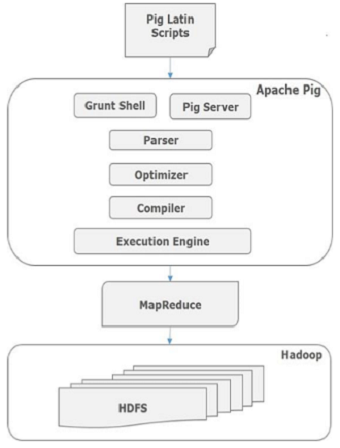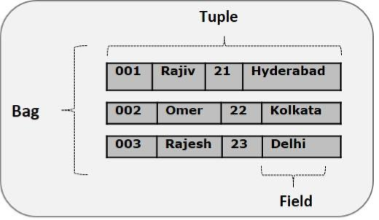
- Apache Pig Tutorial
- Apache Pig - Home
- Apache Pig Introduction
- Apache Pig - Overview
- Apache Pig - Architecture
- Apache Pig Environment
- Apache Pig - Installation
- Apache Pig - Execution
- Apache Pig - Grunt Shell
- Pig Latin
- Pig Latin - Basics
- Load & Store Operators
- Apache Pig - Reading Data
- Apache Pig - Storing Data
- Diagnostic Operators
- Apache Pig - Diagnostic Operator
- Apache Pig - Describe Operator
- Apache Pig - Explain Operator
- Apache Pig - Illustrate Operator
- Grouping & Joining
- Apache Pig - Group Operator
- Apache Pig - Cogroup Operator
- Apache Pig - Join Operator
- Apache Pig - Cross Operator
- Combining & Splitting
- Apache Pig - Union Operator
- Apache Pig - Split Operator
- Pig Latin Built-In Functions
- Apache Pig - Eval Functions
- Load & Store Functions
- Apache Pig - Bag & Tuple Functions
- Apache Pig - String Functions
- Apache Pig - date-time Functions
- Apache Pig - Math Functions
- Other Modes Of Execution
- Apache Pig - User-Defined Functions
- Apache Pig - Running Scripts
- Apache Pig Useful Resources
- Apache Pig - Quick Guide
- Apache Pig - Useful Resources
- Apache Pig - Discussion
Apache Pig - Architecture
The language used to analyze data in Hadoop using Pig is known as Pig Latin. It is a highlevel data processing language which provides a rich set of data types and operators to perform various operations on the data.
To perform a particular task Programmers using Pig, programmers need to write a Pig script using the Pig Latin language, and execute them using any of the execution mechanisms (Grunt Shell, UDFs, Embedded). After execution, these scripts will go through a series of transformations applied by the Pig Framework, to produce the desired output.
Internally, Apache Pig converts these scripts into a series of MapReduce jobs, and thus, it makes the programmer’s job easy. The architecture of Apache Pig is shown below.

Apache Pig Components
As shown in the figure, there are various components in the Apache Pig framework. Let us take a look at the major components.
Parser
Initially the Pig Scripts are handled by the Parser. It checks the syntax of the script, does type checking, and other miscellaneous checks. The output of the parser will be a DAG (directed acyclic graph), which represents the Pig Latin statements and logical operators.
In the DAG, the logical operators of the script are represented as the nodes and the data flows are represented as edges.
Optimizer
The logical plan (DAG) is passed to the logical optimizer, which carries out the logical optimizations such as projection and pushdown.
Compiler
The compiler compiles the optimized logical plan into a series of MapReduce jobs.
Execution engine
Finally the MapReduce jobs are submitted to Hadoop in a sorted order. Finally, these MapReduce jobs are executed on Hadoop producing the desired results.
Pig Latin Data Model
The data model of Pig Latin is fully nested and it allows complex non-atomic datatypes such as map and tuple. Given below is the diagrammatical representation of Pig Latin’s data model.

Atom
Any single value in Pig Latin, irrespective of their data, type is known as an Atom. It is stored as string and can be used as string and number. int, long, float, double, chararray, and bytearray are the atomic values of Pig. A piece of data or a simple atomic value is known as a field.
Example − ‘raja’ or ‘30’
Tuple
A record that is formed by an ordered set of fields is known as a tuple, the fields can be of any type. A tuple is similar to a row in a table of RDBMS.
Example − (Raja, 30)
Bag
A bag is an unordered set of tuples. In other words, a collection of tuples (non-unique) is known as a bag. Each tuple can have any number of fields (flexible schema). A bag is represented by ‘{}’. It is similar to a table in RDBMS, but unlike a table in RDBMS, it is not necessary that every tuple contain the same number of fields or that the fields in the same position (column) have the same type.
Example − {(Raja, 30), (Mohammad, 45)}
A bag can be a field in a relation; in that context, it is known as inner bag.
Example − {Raja, 30, {9848022338, raja@gmail.com,}}
Map
A map (or data map) is a set of key-value pairs. The key needs to be of type chararray and should be unique. The value might be of any type. It is represented by ‘[]’
Example − [name#Raja, age#30]
Relation
A relation is a bag of tuples. The relations in Pig Latin are unordered (there is no guarantee that tuples are processed in any particular order).